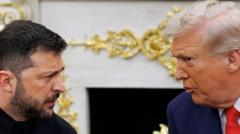In a recent series of summits, the quest for peace in Ukraine continues to present considerable obstacles for President Donald Trump. Following a theatrical meeting with Russian President Vladimir Putin in Alaska, Trump met with six European leaders in Washington, D.C. Although both gatherings had an air of camaraderie, tangible progress remains elusive.
In the aftermath of these meetings, the pressure mounts on Trump, who initially campaigned on the promise of ending foreign wars. However, the meetings did yield a notable development: Trump expressed a willingness to consider U.S. security guarantees for Ukraine, a move seen as crucial by Ukrainian leaders and their European allies. Yet, he quickly amended this stance, suggesting that such commitments might involve air support rather than American troops on the ground.
Trump hinted at potential plans for a direct bilateral summit involving Belarusian President Alexander Zelensky and Putin, though details remain unclear. European leaders voiced a desire for a ceasefire prior to any meeting of the two leaders, a condition Trump deemed unlikely.
While the overall spirit of Trump's discussions was one of cooperation, significant challenges loom on the horizon. Relations between Trump and Zelensky have dramatically improved since Zelensky's contentious earlier visit to the White House. However, Trump's characterization of the situation reveals optimism that may not align with reality, especially given Putin's ongoing military strategy in Ukraine.
International observers highlight the complexity of the diplomatic landscape, noting that Trump's approach to negotiations has shifted from critical to supportive, often in an unpredictable manner. As Trump seeks a legacy as a peace broker, the fundamental question of whether Putin genuinely intends to end the conflict remains unanswered, casting a shadow over the prospects for lasting resolution.
Furthermore, the dynamics of Trump's political base, which favors "America First" and caution against international commitments, add another layer of complexity to any potential peace agreement. Past actions reveal a risk of backlash from his supporters if the U.S. were to shoulder military responsibilities in Ukraine.
Despite the progress made in dialogue and a seemingly positive atmosphere in recent meetings, the stakes remain substantially different for Trump compared to European and Ukrainian leaders. Ultimately, the unpredictability surrounding Trump’s foreign policy approach raises concerns about the sustainability of any agreements reached, highlighting his unique position in the ongoing negotiations. If negotiations stall, Trump possesses the option to disengage entirely, underscoring a significant power dynamic at play in this international dialogue.
In the aftermath of these meetings, the pressure mounts on Trump, who initially campaigned on the promise of ending foreign wars. However, the meetings did yield a notable development: Trump expressed a willingness to consider U.S. security guarantees for Ukraine, a move seen as crucial by Ukrainian leaders and their European allies. Yet, he quickly amended this stance, suggesting that such commitments might involve air support rather than American troops on the ground.
Trump hinted at potential plans for a direct bilateral summit involving Belarusian President Alexander Zelensky and Putin, though details remain unclear. European leaders voiced a desire for a ceasefire prior to any meeting of the two leaders, a condition Trump deemed unlikely.
While the overall spirit of Trump's discussions was one of cooperation, significant challenges loom on the horizon. Relations between Trump and Zelensky have dramatically improved since Zelensky's contentious earlier visit to the White House. However, Trump's characterization of the situation reveals optimism that may not align with reality, especially given Putin's ongoing military strategy in Ukraine.
International observers highlight the complexity of the diplomatic landscape, noting that Trump's approach to negotiations has shifted from critical to supportive, often in an unpredictable manner. As Trump seeks a legacy as a peace broker, the fundamental question of whether Putin genuinely intends to end the conflict remains unanswered, casting a shadow over the prospects for lasting resolution.
Furthermore, the dynamics of Trump's political base, which favors "America First" and caution against international commitments, add another layer of complexity to any potential peace agreement. Past actions reveal a risk of backlash from his supporters if the U.S. were to shoulder military responsibilities in Ukraine.
Despite the progress made in dialogue and a seemingly positive atmosphere in recent meetings, the stakes remain substantially different for Trump compared to European and Ukrainian leaders. Ultimately, the unpredictability surrounding Trump’s foreign policy approach raises concerns about the sustainability of any agreements reached, highlighting his unique position in the ongoing negotiations. If negotiations stall, Trump possesses the option to disengage entirely, underscoring a significant power dynamic at play in this international dialogue.





















